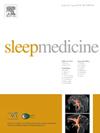Effect of high-intensity interval training exercise on sleep quality in women with probable post-traumatic stress disorder: A pilot randomized controlled trial
IF 3.8
2区 医学
Q1 CLINICAL NEUROLOGY
引用次数: 0
Abstract
Poor sleep quality is a major problem for women with post-traumatic stress disorder (PTSD). Potential causes of poor sleep quality include elevated symptoms of anxiety, hyperarousal, and decreased high frequency-heart rate variability (HF-HRV). Exercise training both decreases anxiety symptoms and increases HF-HRV among samples without PTSD. The effect of exercise training on sleep quality, HF-HRV and PTSD-related symptoms has not been tested in a sample of women exposed to trauma. This study aimed to evaluate the impact of High-Intensity Interval Training (HIIT) on sleep quality in a sample of women with probable PTSD and test if reductions in anxiety or hyperarousal symptoms and/or increased HF-HRV mediate improved sleep quality. Thirty women with poor sleep quality and a Post-Traumatic Diagnostic Scale (PDS-5) score indicative of PTSD (≥ 28) were randomly assigned to either six-weeks of HIIT or a waitlist control (WL). Sleep quality, PTSD and anxiety symptoms were assessed at baseline (BL), weeks 2, 4, 6, and post-intervention (POST). HF-HRV was measured at BL and POST. A mixed model ANOVA 2 group × 5 time interaction for sleep quality was significant (p < 0.001; HIIT BL: 11.27 ± 2.55; POST: 5.60 ± 2.03 versus WL BL: 9.47 ± 2.83; POST: 8.23 ± 2.39; Hedges’ d = −1.57). Anxiety and hyperarousal symptom reductions significantly mediated sleep quality changes. HF-HRV mediation models were non-significant. HIIT-based cycle exercise training in a sample of women with probable PTSD improves sleep quality, and reductions in trait anxiety and hyperarousal symptoms mediated these improvements.
Clinical trial registration
(Clinical Trials. gov) Identifier: NCT05097352.
求助全文
约1分钟内获得全文
求助全文
来源期刊

Sleep medicine
医学-临床神经学
CiteScore
8.40
自引率
6.20%
发文量
1060
审稿时长
49 days
期刊介绍:
Sleep Medicine aims to be a journal no one involved in clinical sleep medicine can do without.
A journal primarily focussing on the human aspects of sleep, integrating the various disciplines that are involved in sleep medicine: neurology, clinical neurophysiology, internal medicine (particularly pulmonology and cardiology), psychology, psychiatry, sleep technology, pediatrics, neurosurgery, otorhinolaryngology, and dentistry.
The journal publishes the following types of articles: Reviews (also intended as a way to bridge the gap between basic sleep research and clinical relevance); Original Research Articles; Full-length articles; Brief communications; Controversies; Case reports; Letters to the Editor; Journal search and commentaries; Book reviews; Meeting announcements; Listing of relevant organisations plus web sites.
 求助内容:
求助内容: 应助结果提醒方式:
应助结果提醒方式:


